(warning: this column contains blurry, low-res images. Please do not adjust your eyes.)
Before "cosplay" was a household word, before cosplay.com and the culture of tribes of teens dressed as anime characters wandering from one hotel ballroom to another, like slightly-more-liable-to-have- bathed-recently Deadheads, had permeated every aspect of anime fandom, in the dark mists of prehistory, even then cosplay still existed. Only recently has documentary evidence come to light, enabling us to finally visualize these anime costumer pioneers.
The March 1987 issue of ANIMAGE gave the Japanese audience a glimpse of what their American counterparts were doing with fabric and foam core. Yes, Virginia-san, there are American anime fans! And they cosplay, too, as was seen in a photo spread helpfully titled "That's American Costume Play!" The Jigen and the Raideen are unidentified, but the modified Gatchaman outfit was created and modeled by Pat Munson-Siter , whose work in the field of pre-1990 anime fandom has rarely been matched.
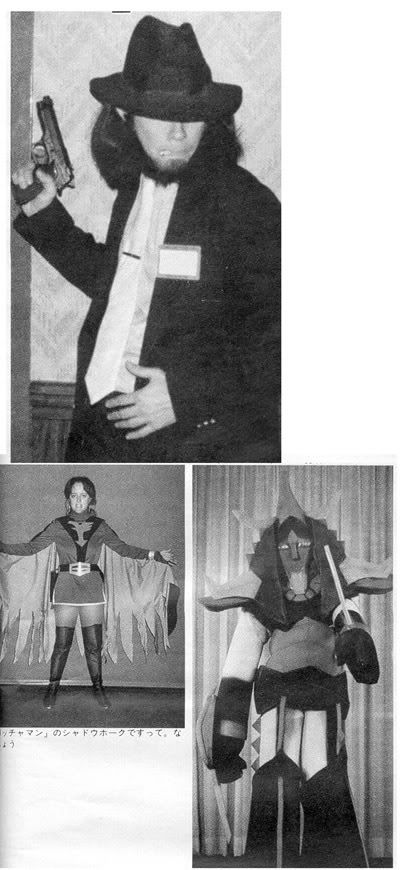
This was not the first ANIMAGE to highlight the champions of foreign otaku (even though the word "otaku" was still in the infancy of its usage) but it would not be the last. Three years later Project A-kon came into being - the first American anime convention, depending on who you ask and what time of day you ask them - and ANIMAGE was there, in spirit if not in flesh, with yet another look at those crazy Americans and their fandom for cartoons in languages they can't understand.
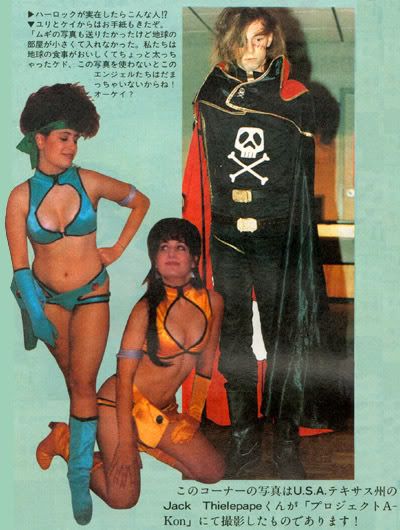
As captured on film by Jack Thielpape, the Dirty Pair pose provocatively as the looming spectre of Captain Harlock ensures a complete absence of any funny business, pal. In the late 80s-early 1990s there were several sets of Dirty Pairs costuming throughout the fandom convention world - one or two in California, a few on the East Coast, and the pair pictured here, who hailed from Georgia and who were actually real-life sisters. Their dedication to the Lovely Angels led them to create several sets of costumes based on the differing suits seen in the TV series, the film, and the OVA releases - even the silver suits from the Takachiho novel (and the Crusher Joe film).
As A-Kon flourished the culture of costuming permeated fandom, and even in late-night after-parties the cosplay spirit can be seen.

The latest in Arcadia-crewmember off-duty loungewear is sported by "S.H." as he digs through a pile of cassette tapes. Yes, cassette tapes, the year is 1992 and Project A-Kon is reeling through the teething pains of its third, crucial year. Meanwhile a Vampire Princess Miyu wonders who these people are and why they're in her hotel room, preventing her from sleeping. As these images were culled from private videotape, identities of our models have been concealed to protect the innocent.
Three years later in Atlanta the first Anime Weekend Atlanta would sport anime costumers from a wide variety of genres and shows. Though we were a few years away from full-blown Sailor Moon Fandom Explosion, the show's effects were being felt even then, as sets of Sailor Scouts competed for the attention of the male anime fan demographic, which had yet to be joined by legions of squealing yaoi anime fangirls. Here we see the first ever Sailor Moon costumer to take the stage at the AWA costume contest, as well as a improvised kickline with a hastily recruited Sailor Mercury.
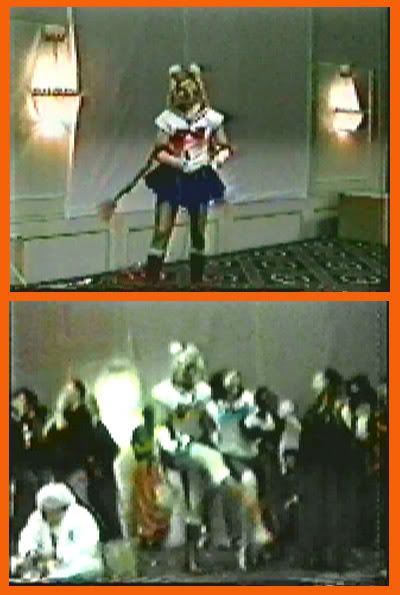
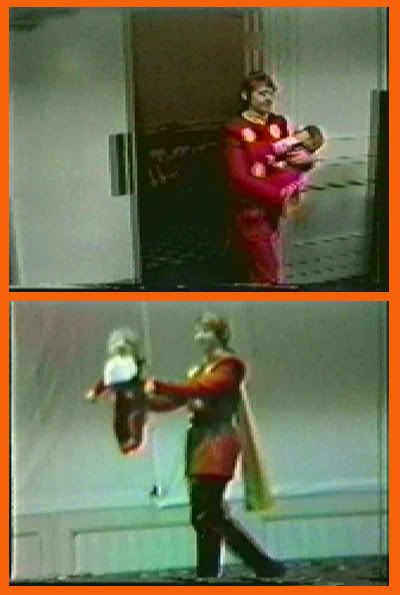
Cyborg 003 and 001, from the 60s and 70s series Cyborg 009, made an appearance as well, highlighting the lingering influence old-school anime had (and has) over certain of the surviving otaku of the area. 003 is portrayed by L.H. while 001 is portrayed by a stuffed doll. Neither possess cybernetic powers.
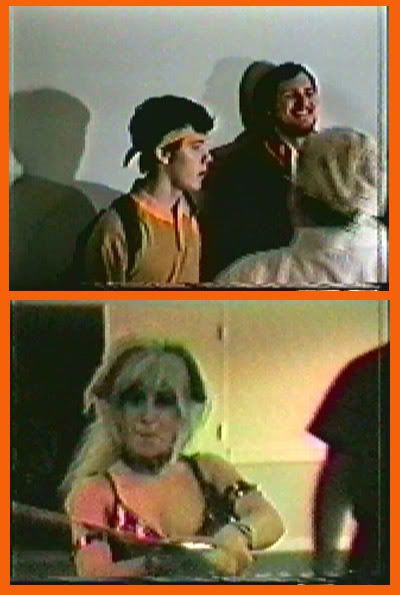
Here we see an example of the near-ubiquitous Ryoga. Ryoga was a character from Ranma 1/2 who got lost a lot, and sometimes turned into a pig. It was a great costume for regular-looking guys who wanted something colorful to dress up as, included a backpack so they could carry their stuff around, and had a ready-made comedy skit that could be rolled out at a moment's notice - run into any crowd of people and holler "I'M LOST!" Boy, that didn't get old AT ALL! Not in the slightest! It's as fresh today as it was back in 1995 when we were already thoroughly sick of Ranma 1/2 in general and that character in particular! Also seen - Princess Kahm from Outlanders, about to cut somebody's head off.
AWA would grow from a few hundred at its first show to over eleven thousand attendees at its most recent gathering, but at the early conventions you could easily fit the entire costume contest and its judges and audience in a medium sized ballroom in a small-to-medium sized airport-area off-ramp hotel. Even the judges got into the act.
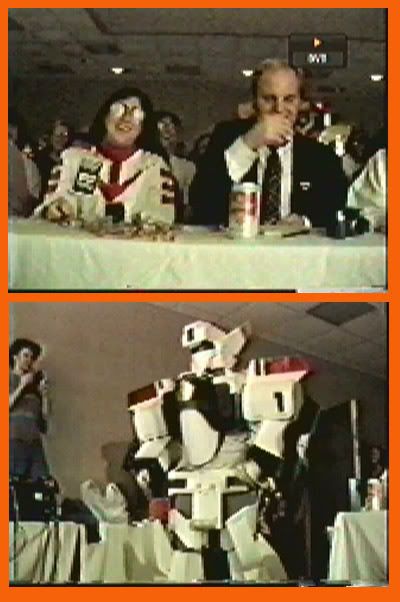
Lorraine "Anime Hasshin" Savage here sports a Yamato crew uniform as she sits next to future Dark Horse Manga editor Carl Horn, cosplaying as future Dark Horse Manga editor Carl Horn. Costuming at the second AWA was of an order of magnitude more impressive than the first year - most notably the Tatarek-built Patlabor Ingram, which was constructed entirely out of space-age foam-core and was mobile enough to enable the wearer to navigate fairly well. The handgun, however, was non-operational. Other, more recent cosplayers, attempting to add functional handguns to their regalia, have attracted the bemused attention of the police department.
As we pass the mid 1990s, we move into a more documented world of cosplay - email mailing lists, digital cameras, and the world of the World Wide Web, which as we all know was created to facilitate the distribution of high quality images of sexy women - would all lead to anime cosplay becoming one of the dominant forces in anime fandom. Gatherings of anime fans today are a swirling mass of strangely garbed people taking photos of each other, the need of otaku to document their strange behavior an irresistable force of nature. But was it always thus? Yus, it wus. These recently unearthed images from 1983 are proof.

As we see from these video images - captured on a rooftop at Constellation, the Baltimore SF Worldcon, in 1983 A.D. - anime fandom was alive, relatively fit, and could stand sunlight for minutes at a time. Representatives of Gundam's Zabi family pose regally, Yamato crewmembers engage in an impromptu kickline with Leader Desslok (what is it with cosplaying fans and their attempts to imitate Rockettes?), and we see actual photographic evidence of Aviator Sunglasses Kei Yuki, as well as several different stages in Captain Harlock's development from skinny space pirate to chubby space couch potato. Upper left: Leader Desslok and Sasha share a moment.
Difficult it may be to concieve of a time when Matsumoto characters were the mainstream of anime fandom and not some kind of atavistic throwback, but pictures don't lie, even if they're low-res video captures. The influence of classic anime continues to linger in cosplay, as the recent AWA attracted Saint Seiya costumers, Yamato costumers, Harlock cosplay, and even 1984-era Macross crewmembers. Is anime costuming moving full circle, back to segregated rooftop gatherings of different Harlock iterations? I hope not. Though, after a long convention season, lord knows we could all use a little sunlight and fresh air.
(images used in this article courtesy Animage, R. Fenelon, and promotional AWA videos produced by M. Murray.)



